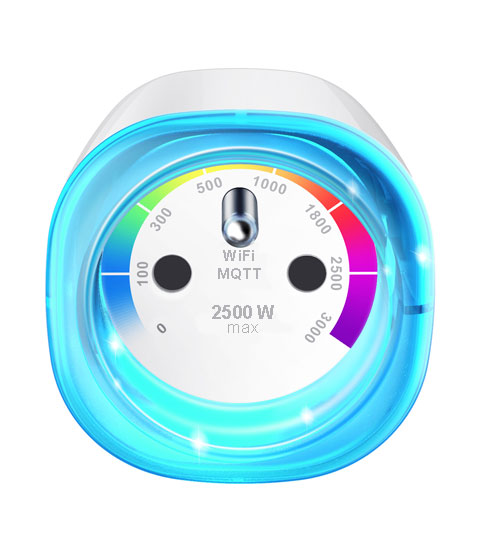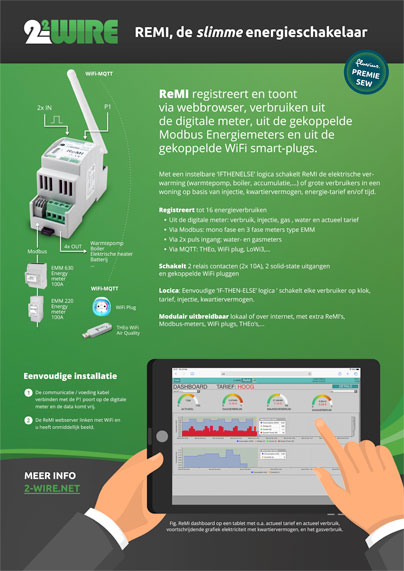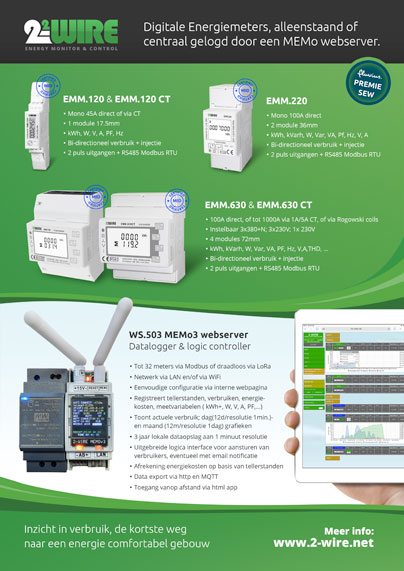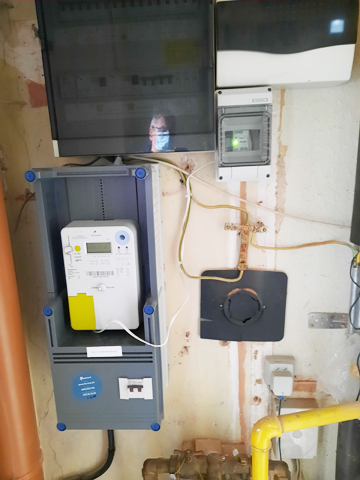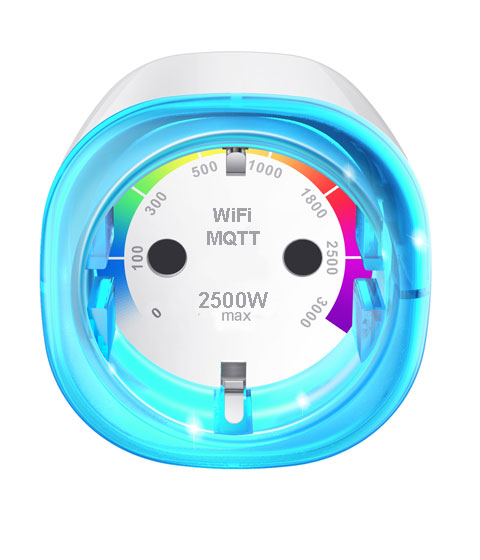Energy transition
In the coming weeks, Fluvius will be organizing a number of partner events. The main theme is the energy transition and what the role of Fluvius is in this as a grid operator. How will we charge our cars in the future? Can our nets handle this?
2-Wire is also participating, with solutions to smartly switch heating and large consumers in homes and buildings based on, among other things, injection and peak consumption.
There are 4 sessions planned:
- March 23, 2022 in Hasselt, Holiday Inn
- March 30, 2022 in Mechelen, Technopolis
- April 20, 2022 in Ghent, Ghelamco Arena
- April 27, 2022 in Kortrijk, Fluvius Kennedy Park
Participation in this event for installers is by invitation by Fluvius.
2-WIRE Product presentations
During these Fluvius events we show our latest developments, ReMI, the smart energy switch, and MEMo3, the 3rd generation Modular Energy Monitors.
Both energy web servers register and display all current and historical energy consumption/costs in homes and buildings, and switch heating based on energy rate, injection, quarterly power,…
The Fluvius premium SEW applies to both products. (Electrical Heat Control). You can download a product info sheet below by clicking on the bitmap.
Prepare for the capacity tariff today!
Have you already installed a digital meter?
Good for you, because such a digital counter is a good stepping stone towards smart energy consumption. Connect a ReMI and/or MEMo3 module to the digital meter and you are ready for the capacity tariff that will be introduced in 2022. With a REMI or MEMo3 you keep your (peak) consumption perfectly under control.
What is the capacity rate?
To avoid peak loads on the electricity grid, the Flemish energy regulator (VREG) will introduce the capacity rate for families and small businesses from July 2022. Instead of basing the ‘distribution costs’ section of your electricity bill solely on the kWh consumption from the grid, the new capacity tariff will take your peak consumption into account. For an average family this will be about 20% of the total electricity bill. It is therefore very important that you avoid consumption peaks.
The calculation of your capacity tariff will be based on the ‘quarter-hour power’: the average power that you take off in 15 minutes. The highest quarter-hourly power that you use in a month is your ‘monthly peak’, which in turn forms the basis for calculating your average monthly peak. Each month, the average monthly peak is calculated by taking the average of the 12 previous monthly peaks. And that average determines the network tariff that you ultimately pay. It is therefore in your interest to keep your quarter-hourly power (or quarter-hourly values) as low as possible, so that your consumption does not show sharp peaks.
Both ReMI and Memo register and monitor these quarter-hour peaks and with both you can smartly switch the heating or other large consumers. This way you not only increase your self-consumption of solar energy, but you also avoid too high quarter-hourly powers.
Project ‘City of things’
In order to achieve the target “Ghent homes consume 30% less energy by 2030”, it is important to map energy consumption of Ghent homes in order to gain insight into the impact of energy-saving renovations.
In addition, Ghent wants to investigate how insight into energy consumption can motivate residents to take further energy-saving steps.
In collaboration with the city of Ghent and with the EnergieID cloud platform, some 200 homes in Ghent will be equipped with a LoWi3 or ReMI web server and associated meters.
fig. In this installation, ReMI measures total consumption (electricity and gas) via its P1 port input, the yield of the solar panels is measured here via an EMM.220 MID.
Project ‘Brussels Cruise terminal’
With a quay of 240 meters long and 12 meters wide, the Brussels Cruise Terminal is the new passenger terminal in the port of Brussels. Located in the outer harbour, next to the “Pavillons Meudon”, the terminal is a berth for inland cruise boats up to 135 meters in length and with space for 200 passengers.
The infrastructure of facility services offers ships at the quay the possibility to switch off their auxiliary engines and to make use of connections on the shore.
The energy and water consumption of moored ships is registered here by a Memo data logger. The link with Plugin2drive offers customers service via mobile access and payment applications and ensures the automatic transmission of the electronic invoice. (fig below: Brussels Cruise Terminal)
Online training via video tutorials
Digital meter, energy monitor, increase self-consumption, avoid peak consumption,… This all sounds very far away to the average installer.
However, the threshold is small. Order one all-in-one ReMi from the better electrical wholesaler, go through the ReMI tutorials, connect it to your digital meter, connect the relays to the devices to be controlled and you’re off to a lower energy bill.
You can also find tutorials for the other web servers LoWi3, MEMo3,… on our website.
New: WiFi-MQTT smart plug
The WiFi-MQTT plug measures the energy consumption of the connected consumer and can also switch it on/off. Switching can be done from the linked ReMI or MEMo3 web server or with the on/off button on the module itself.
The communication for energy measurement and switching is done wirelessly via WiFi 2.4 gHz and then over the internet to the set MQTT account. You can then link this same MQTT account to one or more 2-Wire web servers (LoWi3, ReMI and/or MEMo3), or to your own app or cloud application and in this way read and/or switch the plug from anywhere in the world. .
The RGB LED changes color depending on the current consumption.
With the simple IF-THEN-ELSE logic in the ReMI or MEMo3 module you can switch the plug and therefore also the connected consumer on injection, peak, time and/or time.

